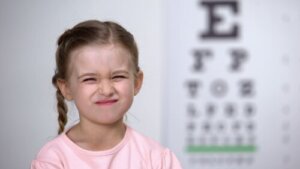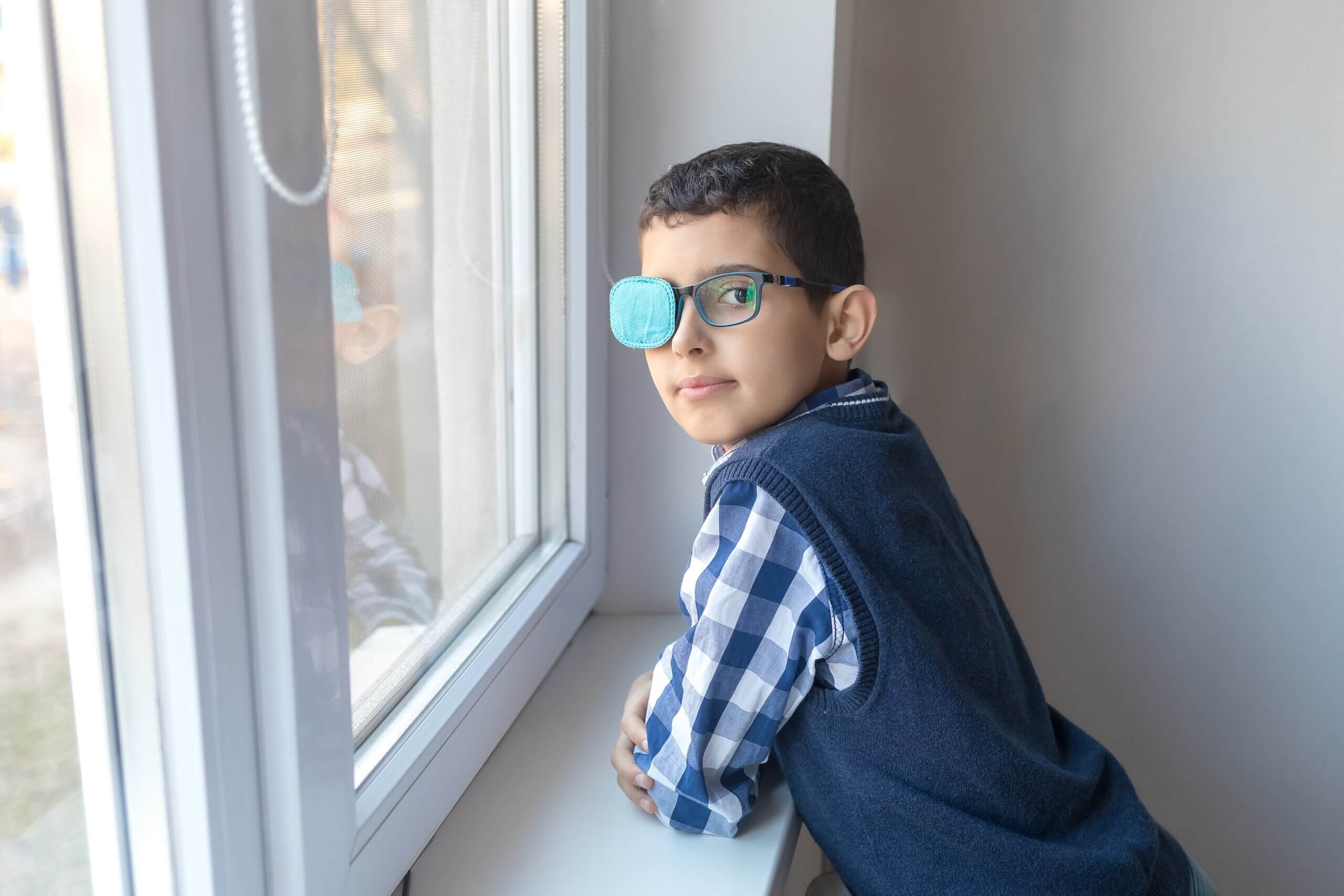The 5 Most Common Vision Problems in Children


Written and verified by the doctor Sandra Golfetto Miskiewicz
Although there are many different eye diseases that can occur in children, there are five vision problems that are the most frequent. In the following article, we’ll mention their characteristics and what signs may lead you to suspect them.
Vision is one of the most important senses for the development of a child. It’s one of the main forms of communication with the external world, especially in the youngest children. For this reason, any impairment of the organ responsible for vision or its connection with the brain can be disabling for the child’s learning and growth. The diagnosis of these diseases should be made as early as possible in order to correct them in a timely manner.
Learn about the most frequent vision problems in children
Among the main vision problems in minors, the so-called refractive errors, such as myopia, hyperopia, and astigmatism, predominate. In these cases, visual acuity is compromised. Here are the 5 most common vision problems in children.
1. Farsightedness
Farsightedness is the most common refractive error in childhood. It’s the inability to see near objects clearly because the image is focused behind the retina. This problem may be physiological (normal) in the first years of life, but as the eye matures, it disappears. However, there are cases where this condition persists for life. The causes of this defect are an eye that’s too short or a cornea that’s too flat, and like nearsightedness, it can be hereditary. To detect farsightedness, there are signs such as the following:
- When the child tilts their head backward to move away from what they’re trying to see.
- Eye fatigue after performing various activities.
- The child squints their eyes to focus on the image.
- The child prefers to carry out activities like reading, drawing, or writing outdoors.
Nearsightedness

This is the most common defect in premature infants. It’s the inability to see distant objects clearly because the image is focused in front of the retina. It usually manifests itself around 6 years of age. The causes of myopia are an eye that’s too long or a cornea that’s too curved. There’s also an important hereditary component. Here are some signs to detect it:
- The child looks at screens or objects very closely.
- Squinting to focus.
- Decreased academic performance, especially if the child sits far away from the blackboard.
- Preferring activities that require the use of near vision.
- Headaches after some visual effort.
3. Astigmatism
In this condition, the retina focuses on images in a distorted way, both near and far. This condition may be associated with myopia or hyperopia. It occurs when there’s an elliptical or poorly spherical cornea, i.e., it’s more curved on one axis than the other, resulting in blurred vision at any distance. These are other symptoms of these defects:
- Increased degree of expected clumsiness, such as constantly bumping into objects or knocking things over.
- Repeatedly closing the eyes, rubbing them, or covering one of them.
4. Strabismus
Strabismus is an eye condition characterized by an abnormal deviation of one or both eyes. Normally, when the child sees objects in space with both eyes, they fuse both images together at the cerebral level. This is called binocular vision. In contrast, in cases of strabismus, the eyes are unable to fixate the gaze simultaneously. This deviation can be horizontal (inward or outward) or vertical (upward or downward). This defect can manifest the following:
- Obvious misalignment of the eyes.
- The eyes don’t move in the same direction.
- The child tilts or twists the head to look at specific points and may develop torticollis.
- The child closes or covers one eye to see.
- Poor depth perception of objects.
Infantile and acquired strabismus
Strabismus can be infantile (before 6 months of age) or acquired (after 6 months of age) and may present certain risk factors:
- Family history
- Genetic disorders (Down syndrome and Crouzon syndrome)
- Prenatal exposure to drugs and alcohol
- Prematurity
- Low birth weight
- Cerebral palsy
The particular case of acquired strabismus may be due to refractory defects, tumors, cranioencephalic trauma, neurological disorders (cerebral palsy, spina bifida, third, fourth, or sixth cranial nerve palsy), and viral infections (encephalitis or meningitis).
False strabismus
It’s important to know how to identify pseudostrabismus or false strabismus. In these cases, there’s no ocular involvement, but the appearance of the child seems to indicate it because the bridge of the nose is very wide and the eyelid folds extending towards the nose are prominent. This makes the eyes appear to be too close together or turned inward.

5. Amblyopia (Lazy eye)
Amblyopia occurs when the vision of one eye is affected by a failure in the sensory nerve communication between the eye and the occipital lobe of the brain. This is because, when strabismus is present, the brain isn’t able to process two different images. For this reason, a compensatory effect is produced which consists of suppressing the less clear image, i.e. the one of the strabismic eye, and a lazy eye is generated. If not corrected before the age of 9, the loss of vision in this eye is usually irreversible.
Other vision problems in children
Other less frequent diseases that still have an important impact on the lives of the children who suffer from them are mentioned below:
- Cataracts: Partial or total opacity of the crystalline lens.
- Nystagmus: Involuntary back-and-forth, rhythmic, and repeated eye movements.
- Congenital glaucoma: This is caused by malformations of the trabeculum, ciliary muscle, and iris, which cause an increase in intraocular pressure and may cause changes in the normal structure of the eye.
- Leukocoria: This is a clinical sign in which instead of a black pupil, a whitish pupil is observed with a whitish reflex to light exposure.
- Corneal abrasion: This is an injury or scratch of the cornea by any object. It usually recovers quickly and spontaneously, but it depends on the severity of the injury.
- Retinoblastoma: This is the most frequent eye tumor in children.
It’s never too early to detect visual problems in children!
All children should undergo an ophthalmologic evaluation before starting school or even sooner if the visual problem is pronounced. Although the most common vision problems may be correctable, they have a significant psychosocial impact on children. You should take into account that the adaptive capacity of children is impressive, so many will develop their other senses to compensate for the one that’s limited.
It’s important to remember that when there are diseases or any other health limitations, this doesn’t only affect children, but also their family environment. They must also learn to manage this condition in order to provide the best possible support. The key point is the early detection and correction of visual problems. In addition, early stimulation of children with visual impairment can be added to ensure that their development is as adequate as possible.
Although there are many different eye diseases that can occur in children, there are five vision problems that are the most frequent. In the following article, we’ll mention their characteristics and what signs may lead you to suspect them.
Vision is one of the most important senses for the development of a child. It’s one of the main forms of communication with the external world, especially in the youngest children. For this reason, any impairment of the organ responsible for vision or its connection with the brain can be disabling for the child’s learning and growth. The diagnosis of these diseases should be made as early as possible in order to correct them in a timely manner.
Learn about the most frequent vision problems in children
Among the main vision problems in minors, the so-called refractive errors, such as myopia, hyperopia, and astigmatism, predominate. In these cases, visual acuity is compromised. Here are the 5 most common vision problems in children.
1. Farsightedness
Farsightedness is the most common refractive error in childhood. It’s the inability to see near objects clearly because the image is focused behind the retina. This problem may be physiological (normal) in the first years of life, but as the eye matures, it disappears. However, there are cases where this condition persists for life. The causes of this defect are an eye that’s too short or a cornea that’s too flat, and like nearsightedness, it can be hereditary. To detect farsightedness, there are signs such as the following:
- When the child tilts their head backward to move away from what they’re trying to see.
- Eye fatigue after performing various activities.
- The child squints their eyes to focus on the image.
- The child prefers to carry out activities like reading, drawing, or writing outdoors.
Nearsightedness

This is the most common defect in premature infants. It’s the inability to see distant objects clearly because the image is focused in front of the retina. It usually manifests itself around 6 years of age. The causes of myopia are an eye that’s too long or a cornea that’s too curved. There’s also an important hereditary component. Here are some signs to detect it:
- The child looks at screens or objects very closely.
- Squinting to focus.
- Decreased academic performance, especially if the child sits far away from the blackboard.
- Preferring activities that require the use of near vision.
- Headaches after some visual effort.
3. Astigmatism
In this condition, the retina focuses on images in a distorted way, both near and far. This condition may be associated with myopia or hyperopia. It occurs when there’s an elliptical or poorly spherical cornea, i.e., it’s more curved on one axis than the other, resulting in blurred vision at any distance. These are other symptoms of these defects:
- Increased degree of expected clumsiness, such as constantly bumping into objects or knocking things over.
- Repeatedly closing the eyes, rubbing them, or covering one of them.
4. Strabismus
Strabismus is an eye condition characterized by an abnormal deviation of one or both eyes. Normally, when the child sees objects in space with both eyes, they fuse both images together at the cerebral level. This is called binocular vision. In contrast, in cases of strabismus, the eyes are unable to fixate the gaze simultaneously. This deviation can be horizontal (inward or outward) or vertical (upward or downward). This defect can manifest the following:
- Obvious misalignment of the eyes.
- The eyes don’t move in the same direction.
- The child tilts or twists the head to look at specific points and may develop torticollis.
- The child closes or covers one eye to see.
- Poor depth perception of objects.
Infantile and acquired strabismus
Strabismus can be infantile (before 6 months of age) or acquired (after 6 months of age) and may present certain risk factors:
- Family history
- Genetic disorders (Down syndrome and Crouzon syndrome)
- Prenatal exposure to drugs and alcohol
- Prematurity
- Low birth weight
- Cerebral palsy
The particular case of acquired strabismus may be due to refractory defects, tumors, cranioencephalic trauma, neurological disorders (cerebral palsy, spina bifida, third, fourth, or sixth cranial nerve palsy), and viral infections (encephalitis or meningitis).
False strabismus
It’s important to know how to identify pseudostrabismus or false strabismus. In these cases, there’s no ocular involvement, but the appearance of the child seems to indicate it because the bridge of the nose is very wide and the eyelid folds extending towards the nose are prominent. This makes the eyes appear to be too close together or turned inward.

5. Amblyopia (Lazy eye)
Amblyopia occurs when the vision of one eye is affected by a failure in the sensory nerve communication between the eye and the occipital lobe of the brain. This is because, when strabismus is present, the brain isn’t able to process two different images. For this reason, a compensatory effect is produced which consists of suppressing the less clear image, i.e. the one of the strabismic eye, and a lazy eye is generated. If not corrected before the age of 9, the loss of vision in this eye is usually irreversible.
Other vision problems in children
Other less frequent diseases that still have an important impact on the lives of the children who suffer from them are mentioned below:
- Cataracts: Partial or total opacity of the crystalline lens.
- Nystagmus: Involuntary back-and-forth, rhythmic, and repeated eye movements.
- Congenital glaucoma: This is caused by malformations of the trabeculum, ciliary muscle, and iris, which cause an increase in intraocular pressure and may cause changes in the normal structure of the eye.
- Leukocoria: This is a clinical sign in which instead of a black pupil, a whitish pupil is observed with a whitish reflex to light exposure.
- Corneal abrasion: This is an injury or scratch of the cornea by any object. It usually recovers quickly and spontaneously, but it depends on the severity of the injury.
- Retinoblastoma: This is the most frequent eye tumor in children.
It’s never too early to detect visual problems in children!
All children should undergo an ophthalmologic evaluation before starting school or even sooner if the visual problem is pronounced. Although the most common vision problems may be correctable, they have a significant psychosocial impact on children. You should take into account that the adaptive capacity of children is impressive, so many will develop their other senses to compensate for the one that’s limited.
It’s important to remember that when there are diseases or any other health limitations, this doesn’t only affect children, but also their family environment. They must also learn to manage this condition in order to provide the best possible support. The key point is the early detection and correction of visual problems. In addition, early stimulation of children with visual impairment can be added to ensure that their development is as adequate as possible.
All cited sources were thoroughly reviewed by our team to ensure their quality, reliability, currency, and validity. The bibliography of this article was considered reliable and of academic or scientific accuracy.
- Salt A and Sargent J. Common visual problems in children with disability. Arch Dis Child. 2014 Dec; 99(12): 1163–1168.
- Garzón-Rodríguez MC et al. Causas de la baja visión en los niños: revisión sistémica. Archivos de la Sociedad Española de Oftalmología. July 2022. doi: https://doi.org/10.1016/j.oftal.2022.06.004
- Khazaeni LM. Estrabismo. MSD Manuals. [Última actualización: feb 2022; citado: 7 septiembre 2022].
- Moguel-Acheita S. Nistagmo en niños: alternativas de tratamiento (Primera de dos partes). Revista Mexicana de Pediatría. 2012:79(5);240-243.
- Rosello A et al. Estimulación temprana en niños con baja visión. Revista Habanera de Ciencias Médicas 2013;12(4):659-670
This text is provided for informational purposes only and does not replace consultation with a professional. If in doubt, consult your specialist.








